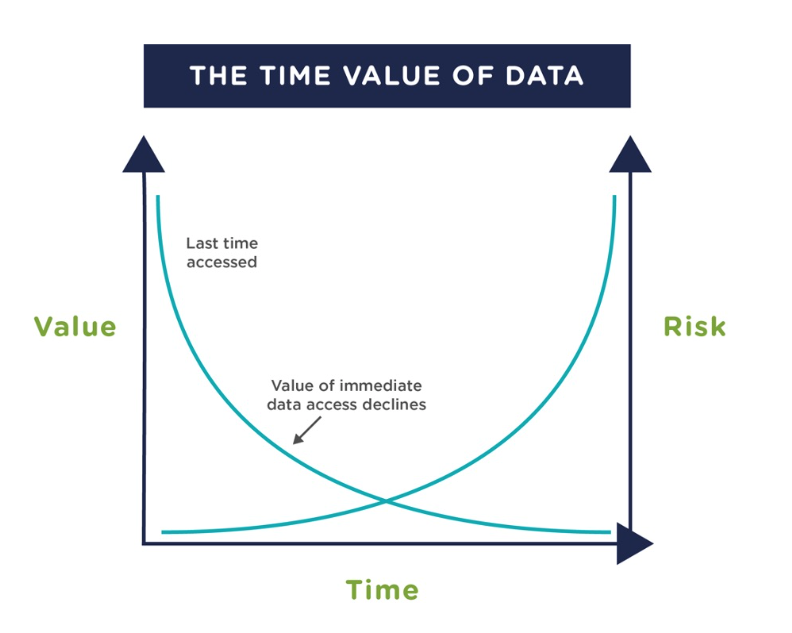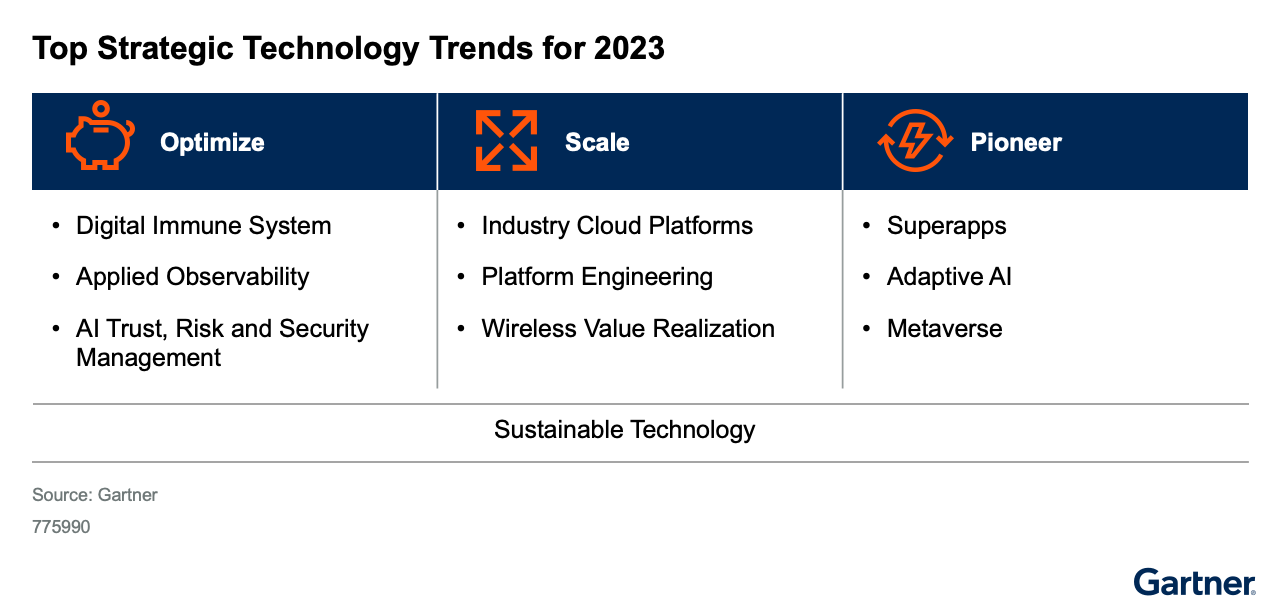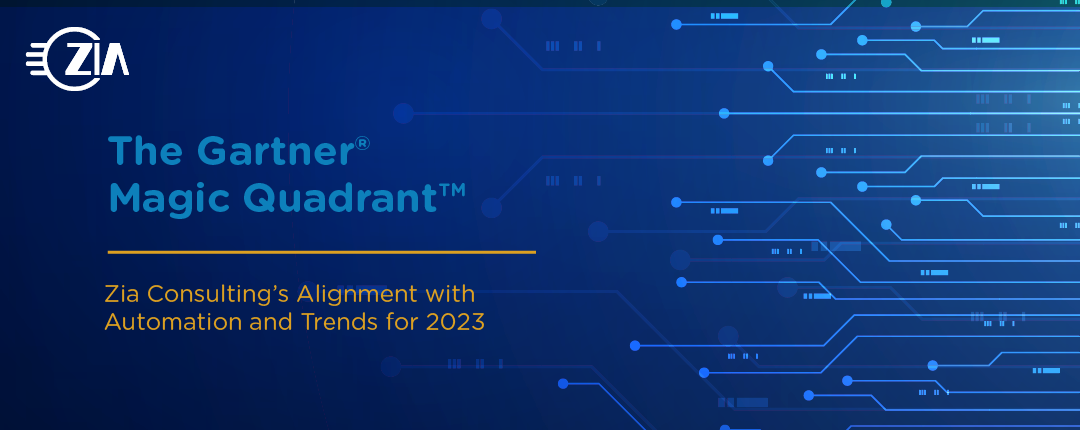Last year we published a blog article, Gartner® Magic Quadrant™: Choosing a Content Services Platform. This article addressed the importance of using digital technology to improve efficiency, value and innovation. Within this, one of the most important components is being able to transform unstructured data into actionable content. We also gave guidelines for interpreting the Gartner Magic Quadrant (GMQ) and its specific application to leaders, challengers, visionaries, and niche players.
In October of 2022, Gartner published their top strategic technology trends for 2023. They begin by emphasizing that organizations must be efficient in their operations, scale their productivity, and pioneer new business models to thrive in times of intense economic and social volatility. Zia Consulting uses disruptive innovation and digital transformation to do exactly that. We help customers look thoroughly and critically at their business processes – even if it makes them a little uncomfortable. Why? Because it is a necessary step in innovating.
At Zia, we like to say, choose to disrupt or be disrupted. Disruptive innovation happens when new products and services emerge from the bottom of a market, making them less expensive and more accessible to the public. Digital transformation is the implementation of the new technologies, talent, and processes that make innovation possible, improve business operations, and deliver more value and satisfaction to customers. When done well, disruptive innovation and digital transformation move companies upmarket. Sometimes it takes the creation of new business models to evolve, remain competitive, or even displace the competition.
Opportunities
Gartner’s recent trends report highlights the opportunity for IT leaders to advance their financial positions during turbulent times, scale organizational productivity by empowering agile teams, and reinvent business models by accelerating digital transformation.
Part of disrupting is being able to look beyond cost savings and develop new forms of operational efficiency. Doing this creates an opportunity to preserve margin and reinvest in sustainable technologies. Let’s look at how this can be applied to helping companies deal with the massive amount of data they have. While the conventional wisdom may be to hold onto data, it can cause a lot of problems.
When you hold onto data, the value decreases and the risk increases.

In an ASG Technologies podcast called Information is Power with Chris Sudak, Chris calls this Data Diabetes. By this he means that hanging onto too much data leads to an inability to properly metabolize it fast enough and effectively enough to follow the data-information-insight-action chain. When unable to fully monetize assets, companies take significant losses from untapped data.
Changes that have taken place since COVID-19 offer additional opportunities. Supply chain issues, skills shortages, and the shift toward hybrid work culture make it possible for IT leaders and other executives to scale their organizational productivity with agile teams that collaborate in digital ecosystems. It has become critical to get digital quickly and Zia can help!
Brief Summary of 2023 Trends

The first trend is optimizing operational sustainability. This involves using AI-infused technology capabilities to observe and predict system and user behavior. Then apply what has been learned to prevent failures and adapt product and process capabilities more autonomously. These three sub-categories are described in greater detail.
- Optimize resilience through digital immune system
- Optimize operations through applied observability
- Optimize trust through AI trust, risk and security management
Zia can help with operational sustainability by taking a holistic look at your business and IT processes, as well as the data and content that moves through your systems. From there, we can focus on automating core processes. Rather than taking the approach that everything can be automated with a bot, Zia uses a qualitative and quantitative approach to evaluate the viability and sustainability of your processes against a set of criteria. By doing this, we can determine what aspects are candidates for automation. This informs your business, provides focus, and improves operational sustainability by automating the intake of content and data, determining if it needs to be stored and protected, applying that protection as a forethought instead of at the end of the process, and taking the human out of the equation in most situations.
Automating this process is the only way to handle the volume of content and data that comes into an organization. Most of our clients want to understand the building blocks of digital transformation and evaluate their readiness to transform and automate. Zia helps assess where they are in their transformation journey by looking at each of the 6 components of digital transformation shown below.

The second trend is scale productivity and customer value. This combines industry-specific with optimized developer platforms and sensing technology to deliver and scale sector-specific enterprise value. The report goes into greater detail in these three areas.
- Scale vertically through industry cloud platforms
- Scale software delivery through platform engineering
- Scale everywhere through wireless value realization
We are most excited about creating customer value and improving productivity with our customers. We have found that many organizations struggle to replatform or move to cloud platforms with their existing infrastructure. We address this using the five part methodology that is shown below. Using this process, we help our customers diagnose and make the best choice about what to do with their existing infrastructure. They determine if they can, (1) Retire or sunset certain applications, (2) Replace them with a new software and platforms, (3) Rehost or move them to the cloud, (4) Rewrap or implement an API to keep applications functioning as part of their ecosystem, and/or (5) Redo or completely rethink and automate the business process.

Finally, they discuss the importance of using new technologies to support unique consumer expectations within social, economic, or technology communities. Subcategories covered here include:
- Pioneer engagement through superapps
- Pioneer acceleration through adaptive AI
- Pioneer virtual opportunities through metaverse
Of course, sustainable technology themes are impacted by the shared responsibility of environmental, social, and governance expectations and regulations. Gartner recommends that all investments in technology are measured against the environmental impact that future generations will endure. Today’s companies want improved efficiency, productivity, customer and employee satisfaction, and overall ROI. However, this needs to take place while also reducing their carbon footprint and supporting the larger society.
Zia Consulting is at the forefront of thinking through these challenges. Our model is built on understanding your business problems and creating a plan that provides quick wins that align with your overall priorities and company values. Contact us today to learn more about how Zia applies these trends to the way we do business.

ABOUT THE AUTHOR
Shelly Mahon, VP of Marketing
After a long career of researching, teaching, writing, editing, speaking, developing and marketing parent education programs and products, and serving as the executive director of a non-profit, Shelly has landed as the VP of Marketing for Zia Consulting. She works with the company’s marketing, sales and executive teams to implement a strategic marketing plan focused on lead generation, brand awareness, and client and partner support. She also conducts market research, and assists the sales team in supporting existing clients and moving prospective clients through the sales funnel. She is passionate about building relationships and working in a way that is focused on being efficient, effective, and thoughtful. When not at work, she is an avid cyclist, mountain-biker, skier, runner, and parent educator.

